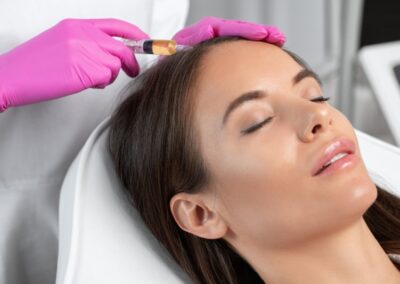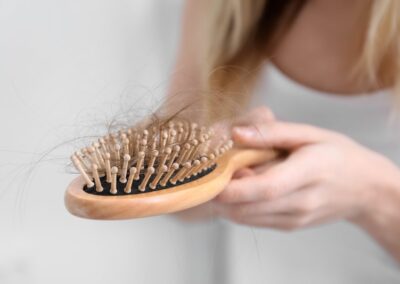Alopecia Areata
What is Alopecia Areata?
- Alopecia areata is a skin condition that causes a sudden loss of patches of hair on the scalp and sometimes other parts of the body.
- Alopecia Areata is nonscarring, which means that there is no permanent damage to the hair follicle.
- In most people, new hair eventually grows back in the affected areas, although this process can take months.
- Approximately 50 percent of people with mild alopecia areata recover within a year; however, most patients with alopecia areata will experience more than one episode during their lifetime.
- Approximately 1 person in 50 will suffer from alopecia areata at some point in their life.
- It occurs in men and women of all races equally.
- The condition can develop at any age, although most people develop alopecia areata for the first time before the age of 30.
- Alopecia areata is not life-threatening and does not cause physical pain. However, the psychosocial effects of hair loss can be devastating.
- In addition, patients may experience symptoms related to hair loss, such as increased eye or nasal irritation after loss of eyelash or nasal hair.
- The chances of developing Alopecia Areata is slightly more likely if you have a relative with it, or if you have family members with autoimmune diseases such as, Thyroid disease, Vitiligo, Polyglandular Autoimmune Syndrome Type 1, or Down Syndrome.
- Alopecia areata is a very unpredictable disease. In some people, hair grows back only to fall out again later while in others it remains long-term.
- Even when hair loss is total over the whole body, there is a chance it will grow back.
What is the incidence of alopecia areata and how does it occur?
- Alopecia areata occurs worldwide. The estimated prevalence is approximately 1 in 1000 people, with a lifetime risk of approximately 2 percent.
- Both children and adults may develop alopecia areata, and the disorder occurs at similar rates in males and females.
- An analysis of clinical data collected from the population of Olmsted County, Minnesota between 1990 and 2009 revealed a mean age for diagnosis of 292 alopecia areata patients was 32 years in males and 36 years in females.
- Whether there is a seasonal pattern for flares of alopecia areata is unclear.
- Alopecia areata is an autoimmune disease in which hair follicles in the growth phase (anagen) prematurely transition to the nonproliferative involution (catagen) and resting (telogen) phases. This leads to sudden hair shedding and inhibition of hair regrowth.
- Unlike some other types of alopecias (e.g. cicatricial or scarring), the inflammatory process in alopecia areata does not lead to permanent destruction of the hair follicle.
- Loss of immune function; the way our immune system can defend our body; and genetic predisposition all play an important role in pathogenesis of alopecia areata.
Sources:
Madani S, Shapiro J. Alopecia areata update. J Am Acad Dermatol 2000; 42:549.
What are the different types of Alopecia Areata?
- Patchy Alopecia is the most common pattern with circular or patchy bald spots of normal-appearing skin.
- The scalp is the most common site but beards, eyelashes eyebrows and any other hair-bearing areas can be involved.
- Less common forms of Alopecia Areata include Alopecia Totalis (complete loss of scalp hair which impacts about 5% of all patients with hair loss related to the immune system
- Alopecia Universalis (complete loss of body hair) impacts 1% of the population.
- Ophiasis Alopecia Areata is a bandlike hair loss on the temples.
- Sisaipho (Ophiasis spelt backwards) is the reverse of Ophiasis and occurs when hair loss is similar to male pattern baldness (on the frontal, temporal and parietal scalp or top of the head).
- Sudden greying – loss of pigmented hairs or going white overnight
- Diffuse Alopecia Areata – this type causes widespread and rapid hair loss
- There are no differences in appearances with skin colour.
Source: Dermnet – Alopecia Areata
What are the symptoms of Alopecia Areata?
- Any of these conditions usually have telltale signs of clumps of hair in the shower, sink or hairbrush (more than 150 hairs a day is not normal).
- Many patients will notice localised tingling or itching preceding the hair loss.
- Hair often falls out in clumps the size and shape of a 50c piece, in some just a few spots, in others it may be more widespread.
- Nail changes are associated with more severe forms of the disease and impact 10-40% of patients
These Include
- Red spots in the lunula (the fingernail moon)
- Koilonychia (when central part of the nail is depressed)
- Onychomadesis (separation of the nail plate)
- Trachyonychia (rough longitudinal ridges that usually develops in childhood)
- Nail pitting (dents ridges and holes)
- Ridging (vertical or horizontal nail ridges)
- Onychorrhexis (vertical ridges in the nail)
Source: Dermnet – Alopecia Areata
How is Alopecia Areata diagnosed?
- Dr Parisa Arianejad (FACD, MD) is highly experienced in hair loss diagnosis and will use a Trichoscopy test (examination of the hair follicle, shaft and scalp) under a dermatoscope.
- She will also perform a hair pull test using gentle traction which is positive when more than 10% of hairs are easily pulled out.
- If the diagnosis is uncertain she may also perform a skin biopsy.
- Alopecia Areata is frequently misdiagnosed as many other conditions including Trichotillomania (psychological hair pulling condition); Discoid Lupus Erythematosus (an autoimmune condition of the skin that impacts the scalp) as well as secondary syphilis (STD) and frontal fibrosing alopecia (permanent hair loss).
- It may also be misdiagnosed as male pattern baldness. That’s why a dermatologist can be very useful in diagnosing hair conditions.
- Dr Parisa has a fellowship in dermatology from the Australasian College of Dermatologists.
- She also runs a specialised hair disease clinic at Westmead Public Hospital and is a member of the International Society of Hair Restoration Surgery, the global medical body dedicated to promoting the gold standard of medical practice and medical ethics in hair restoration.
- Dr Parisa has trained under world-leading professionals in hair disease treatment and is highly experienced in treating hair disorders from the common to the complex – including male pattern baldness, alopecia areata, receding hairline as well as pregnancy and menopause related hair loss.
What are the treatments for Alopecia Areata?
Not all people with alopecia areata require treatment; many patients with limited disease will experience spontaneous hair regrowth.
- Treatments for mild alopecia areata where less than half of the scalp is involved include corticosteroid injection into patchy areas of the scalp repeated four to six weekly..
- Topical treatments include corticosteroid solutions, creams and ointments
- Platelet rich plasma for hair loss is also performed at Aurora Dermatology for Alopecia Areata.
- Oral Minoxidil (in combination with other treatments)
Topical immunotherapy – involves applying a substance known to cause an allergic reaction to the area of hair loss.
The resulting itching, scaling, and irritation often induce hair growth.
Treatments for extensive alopecia areata include:
1. Systemic corticosteroids
2. Oral immunosuppressants: such as methotrexate cyclosporine and azathioprine may be used in severe cases
3. Investigational treatments – New therapies for alopecia areata are emerging. The preliminary results from drugs known as Janus kinase (JAK) inhibitors such as Baricitinib, tofacitinib and ruxolitinib are promising first line treatments for very severe hair loss.
However they should be used judiciously and not in certain groups.
The TGA has recently issued a warning about side effects and suggest limiting use in people who smoke, who are over 65, or who have had stroke or heart disease or are at increased risk of cancer.
Remember alopecia areata may spontaneously resolve, persist, relapse and/or progress.
Dr Parisa will be able to explain various possible disease courses to help you find the best treatment for your hair loss.
How do I hide my hair loss?
- Hair camouflage ideas include full wigs, hair pieces, hair extensions in the area of alopecia and false eyelashes or artificial eyebrows or eyebrow tattooing.
- Styling products such as mousses and powders can help keep hair in place and help achieve coverage and add volume.
- “An asymmetrical parting with a deep side parting can make a sweeping fashion statement and also conceal receding hairlines for the ladies”, says celebrity hairstylist and one of Huffington Post’s top global beauty influencers for the over 45s Mary Zavaglia.
- “Clever styling with headbands, scarves and hats can also disguise hair loss. As can long, thick bangs, a line bob or a jagged layered fringe or even layers around the face.
- “Half up or half down is good if there is receding hairline at the temples (as some of the down hair can disguise missing hair), while a deep side part (the further back from the rear) can also help.”
- Styling with scarves and headbands is also an effective way to reduce a high forehead or thinning hairline, she says.
- You can also use eyeliner or mascara to add extra density to thinning levels of hair.
Why is hair loss so devastating – especially for women?
“Hair loss can cause huge psychological devastation, sometimes even more so for women because baldness is somewhat more expected in men than it is in women,” says Dr Parisa.
One study from the Royal Australian College of General Practitioners (RACGP)* found that 52% of women were “extremely upset” by baldness, compared to 28% of men – with more than 40% of women experiencing marital problems and 64% career difficulties attributed to hair loss.
That’s why psychosocial support plays such an important role in the management of alopecia areata.
Dr Parisa can discuss these options with you.
What is the prognosis and outcome for alopecia areata?
Poor prognostic factors include younger age of onset, more extensive disease, nail dystrophy, family history and presence of atrophy or other autoimmune disease.
Like any disease, there is often a far better prognosis with early treatment (before one year’s duration of hair loss).
Source: RACGP Female Pattern Hair Loss





